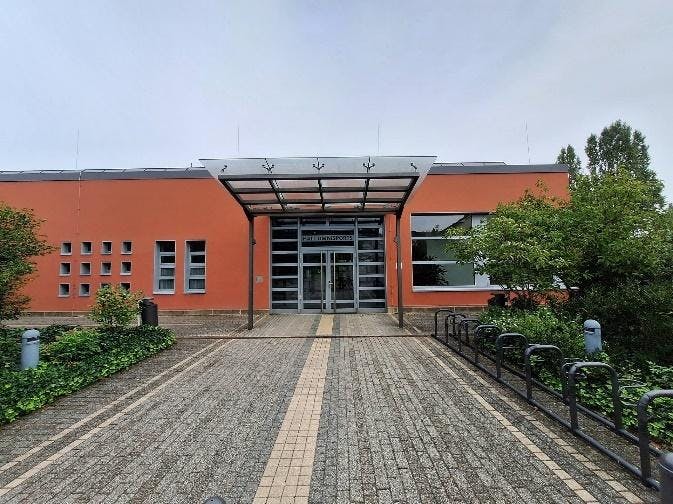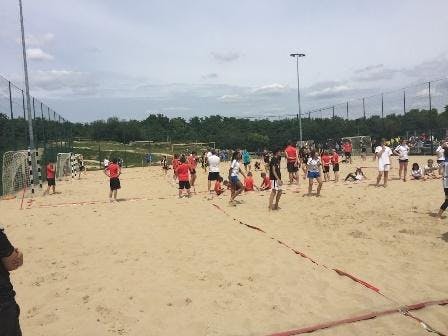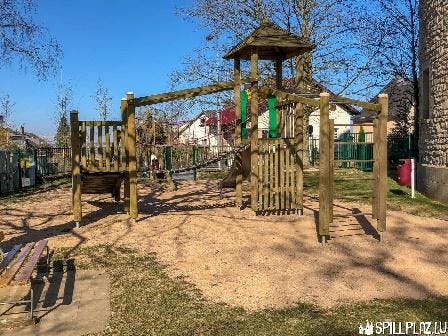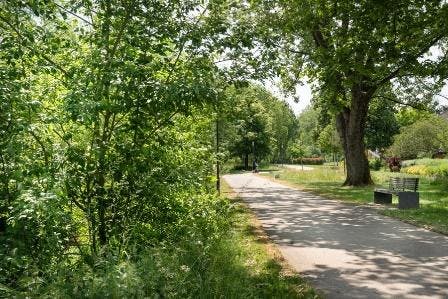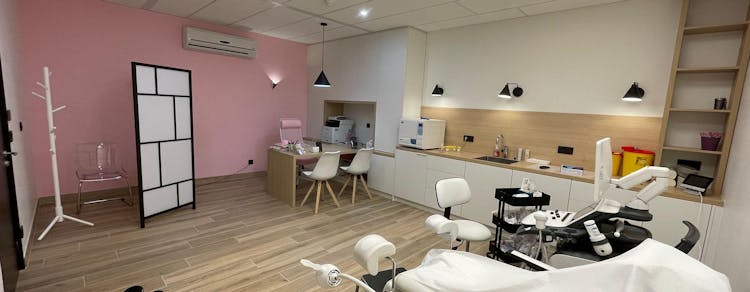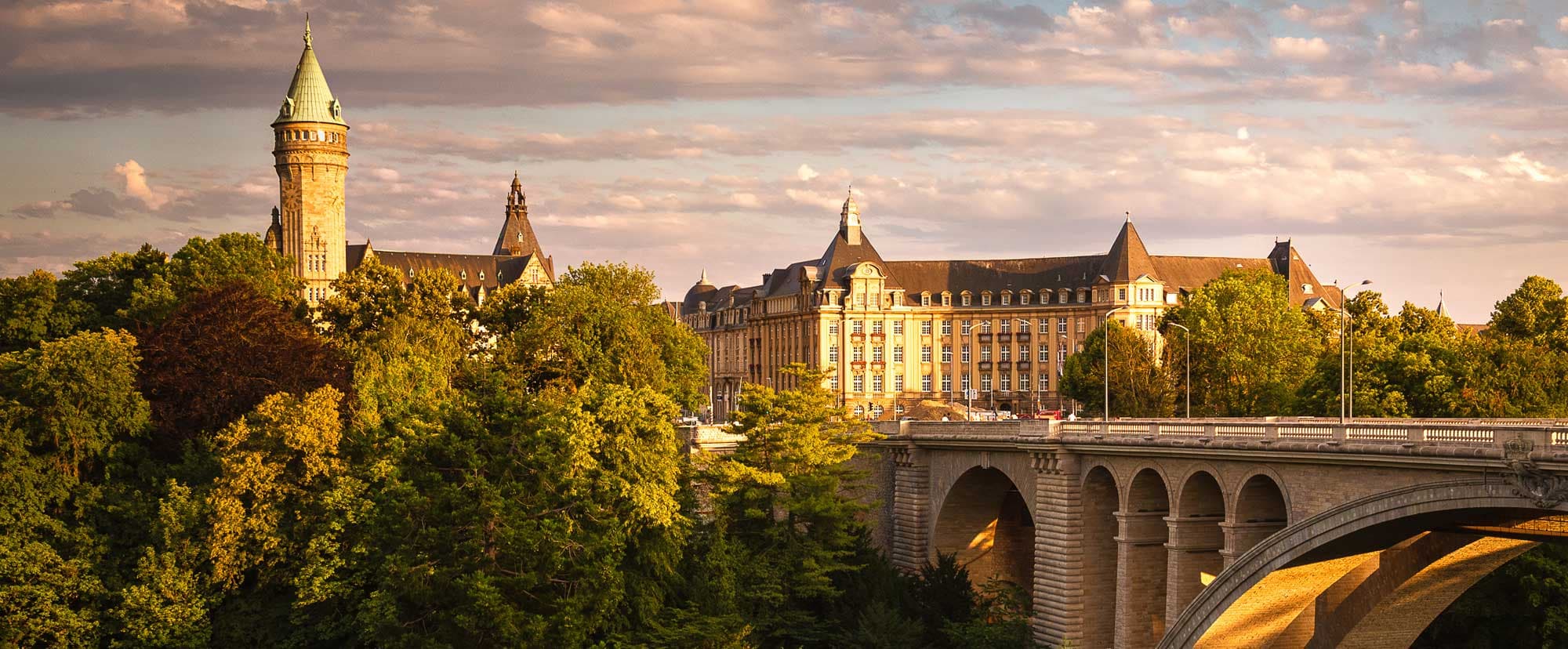
Cessange: spacious green neighborhood in Luxembourg
In this article, we embark on a journey through the historical corridors, explore the vibrant population, weigh the pros and cons of residing in Cessange, dissect the area's transport accessibility, take a closer look at its infrastructure, and navigate the nuances of renting and buying real estate.
Nestled at the southwest border of the capital, Cessange is a sprawling neighborhood that shares its boundaries with Merl and Hollerich to the north and Gasperich to the east. This expansive area enjoys an enviable location, seamlessly blending urban convenience with natural surroundings, while also boasting close proximity to major highways and the burgeoning economic hub of Cloche d'Or.
General characteristics of Cessange
The center and the northeastern corner of Cessange are predominantly urbanized, serving as a residential hub, while the rest of the neighborhood boasts expansive agricultural landscapes. Currently undergoing significant development, Cessange has become a hotspot for real estate investors, capitalizing on its strategic location and proximity to the thriving economic center of Cloche d’Or.
Notable projects like "Rue Verte," featuring nearly 200 residences, 1,600 square meters of office space, and 800 square meters of commercial establishments, and "Gudde Bierg," envisioning over 400 new homes, contribute to the neighborhood's transformation.
Population of Cessange neighborhood
As of January 1, 2024, Cessange's population stood at 5,067, constituting 3.82% of the capital, Luxembourg City. Spanning an expansive 657.83 hectares, it holds the distinction of being the largest neighborhood, with the majority residing in the center and the northeastern quadrant. Positioned midway in population density, Cessange boasts a 66.57% foreign resident rate, slightly below the capital's average of 70.44%.
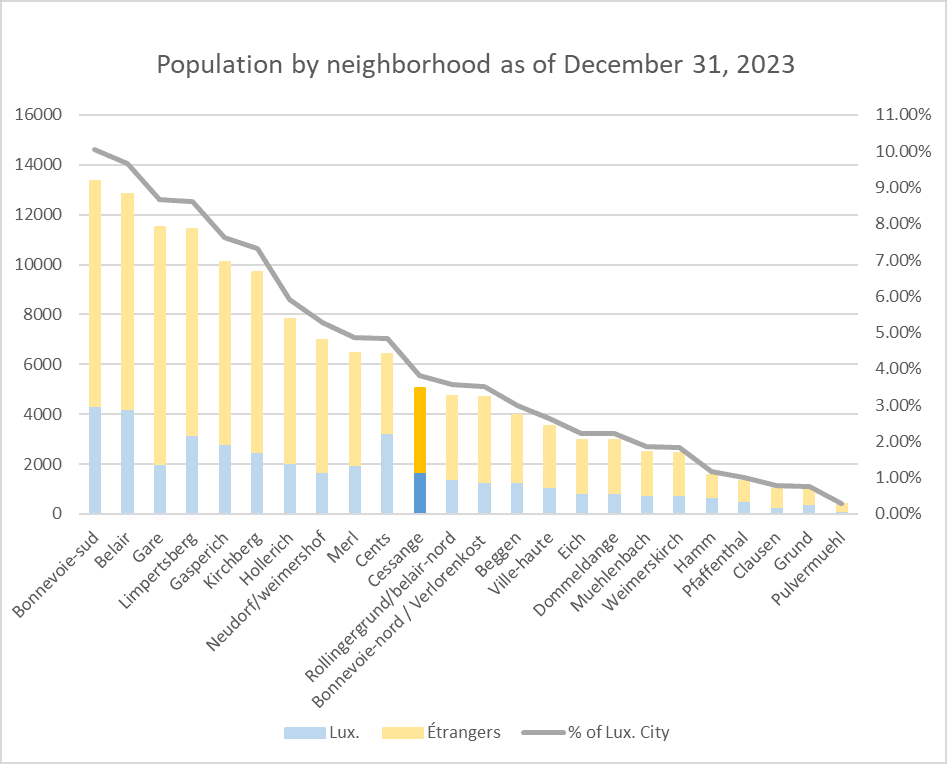
Transport accessibility
Cessange, being a sizable neighborhood, exhibits varying distances depending on one's starting point within the district. The transport options available contribute to the overall connectivity, catering to diverse commuting preferences.




You can check the route of each bus line in detail on the interactive map provided by the city of Luxembourg and get detailed instructions to get from one point to another on their route planner page.
Renting and buying real estate
Real estate prices in Cessange are relatively affordable, with purchasing costs at 11,375 euros/m², slightly lower than the capital's average of 12,243 euros/m². On the rental front, the rates stand at 31.03 euros/m², slightly above the city's average of 30.72 euros/m².
For purchase prices stand at
For renting prices stand at
Applications, search and profound advice in our guide to rent in Luxembourg

Infrastructure of the neighborhood
Cessange, predominantly a residential haven, surprises with a diverse infrastructure, especially in the realm of sports. The notable Boy Konen Sports Fields showcase this commitment, featuring football pitches, a rugby field, a beach volleyball court, a hockey field, and a unique mountain bike training track.
In addition to its existing facilities, Cessange is at the forefront of urban development. The ongoing "Rue Verte" project, currently under construction, promises nearly 200 residences, 1,600 square meters of office space, and 800 square meters of commercial establishments. Furthermore, the ambitious "Gudde Bierg" project aims to introduce over 400 new residences, contributing to the neighborhood's evolving landscape and enhancing its infrastructure for residents.
If you're considering making Luxembourg your new home, we encourage you to explore our range of articles that look in depth at the different city communes and neighborhoods.
Pros and cons of living in the Cessange neighborhood
Cessange's prime advantage lies in its strategic location, offering proximity to major highways and the burgeoning Cloche d'Or business park. However, the neighborhood's slight distance from the city center means that walking to downtown takes considerable time, and public transport commutes to opposite areas, like the Kirchberg business district, can be time-consuming.
Primarily a residential and family-oriented area, Cessange provides a tranquil retreat from the city's hustle, making it highly appealing for those with private vehicles. On the downside, the predominantly residential nature might lead to a shortage of local amenities and cultural establishments. Yet, with ongoing real estate projects and the neighborhood's rapid development, there's potential for a significant increase in infrastructure and commercial offerings in the near future.
An additional advantage is Cessange's distance from Findel Airport, being the farthest from it among the city's neighborhoods, resulting in minimal aircraft noise disturbances compared to other areas. Living in Cessange presents a unique blend of tranquility and convenience, with evolving prospects shaping its future appeal.An additional advantage is Cessange's distance from Findel Airport, being the farthest from it among the city's neighborhoods, resulting in minimal aircraft noise disturbances compared to other areas. Living in Cessange presents a unique blend of tranquility and convenience, with evolving prospects shaping its future appeal.
What can you find in this neighborhood of Luxembourg City
Cessange boasts two primary schools, the public École de Cessange and the private Gaston Thorn International School, the second one embodying values of democracy, music, and the digital world for young learners. While the private school extends to secondary education, Cessange currently hosts primary-level facilities.
Complementing these are a public childcare center and a multitude of nurseries, including Amitola, Les P'tits Bouchons, La Petite Sirène, Le Jardin D'eveil, and L'enfant Roi.
Although the neighborhood lacks universities, the proximity of the Geesseknäppchen Campus in the adjacent Hollerich district is noteworthy. This campus houses numerous secondary schools and universities, such as the Ecole de Commerce et de Gestion and the Wedge Business School. Additionally, to the southeast lies the European Institute of Excellence Business School (EIEBS), further enriching the range of nearby educational institutions.
Cessange primary school
- Address: 226 Rue de Cessange, Cessange Luxembourg
- Phone: (+352) 47 96 68 51, Website: vdl.lu.
Childcare center
- Address: 217 Rue de Cessange, Cessange Luxembourg, Phone: (+352) 47 96 32 01, Website: vdl.lu.
- Address: 21 Rue Verte, Cessange Luxembourg, Phone: (+352) 47 96 22 20, Website: vdl.lu.
Gaston Thorn International School
- Address: 23 Rue Verte, Cessange Luxembourg.
- Phone: (+352) 26 04 61 50, Website: eigt.lu
Amitola Nursery
- Address: 3 Rue des Frênes, Cessange Luxembourg.
- Phone: (+352) 26 19 68 20, Website: amitola.lu
Les P'tits Bouchons Nursery
- Address: 21 Kohlenberg, Cessange Luxembourg.
- Phone: (+352) 27 93 40, Website: lesptitsbouchons.lu.
La Petite Sirène Nursery
- Address: 115 Rue de Cessange, Cessange Luxembourg.
- Phone: (+352) 26 48 21 59, Website: lapetitesirene.lu.
Le Jardin D'eveil
- Address: 104 Rue de Cessange, Cessange Luxembourg.
- Phone: (+352) 27 76 67 01, Website: creches-jardin-eveil.com.
L'enfant Roi Nursery
- Address: 12C Imp. Drosbach, Cessange Luxembourg.
- Phone: (+352) 2 73 22 51, Website: lenfant-roi.lu
Cessange boasts two cultural establishments, a public Cultural Center located towards the center of the neighborhood, and further north, the private event venue, Chouchou. The latter hosts a myriad of events and concerts in its expansive 500m² space spread over two floors, complemented by a 100m² terrace. Exquisitely adorned with a blend of greenery and vintage chandeliers, Chouchou seamlessly merges the modern with the antique, creating a warm and inviting ambiance. While Cessange offers these cultural centers, neighboring districts become the go-to destinations for a broader array of events and facilities.
Cessange Cultural Center
Chouchou
Learn more about Luxembourg's culture and traditions in our special guide.
While Cessange lacks hospitals or clinics, residents can rely on the nearby Medical Center Médalouse at the eastern border in Gasperich. This facility encompasses a gynecologist, a general practitioner, and the Ketterthill medical analysis laboratory.
One may need to venture outside the neighborhood for more comprehensive medical services. However, swift access to the city's major hospitals is facilitated by car, with public transportation providing slightly longer travel times. Here are the addresses and distances to some of the city's prominent hospitals:
Clinique Zitha
Kirchberg Hospital
Centre Hospitalier de Luxembourg
CHL Eich
You can read more about urgent healthcare in our dedicated article: Emergency medical help in Luxembourg: ambulance and hospitals.
Cessange offers a variety of playgrounds for children scattered throughout the neighborhood, with locations on Rue de Cessange, Rue des Artisans, Rue Kohlenberg, within the primary school premises, and the childcare center.
The standout feature of Cessange is the expansive Cessange Park, a vast green expanse teeming with nature at the heart of the neighborhood. The extensive public park begins opposite the Fischerhof bus stop, stretching alongside the Zéissenger stream. Picturesque wooden bridges span the watercourse, lined with larches, summer linden trees, chestnuts, and alders, creating a scenic pathway through the elongated park. Surprisingly, at its end, the park offers the opportunity to engage in beach volleyball, adding a versatile recreational element to this natural haven in the midst of Cessange.
Playground on Cessange Street
Playground Kohlenberg
Playground Rue verte
Childcare center Playground
Playground Rue des Artisans
Cessange Park
Cessange features limited sports facilities in the neighborhood center, including a small football field behind the cultural center and a multipurpose sports facility within the primary school premises. However, access to the latter is restricted to official city schools and clubs.
Fortuitously, Cessange benefits from an expansive sports complex at the southern end of the neighborhood, the Boy Konen Sports Field. This extensive area encompasses various sports facilities, including two football pitches, a rugby field, a beach volleyball court, a hockey field, and a mountain bike training track.
The rugby field serves as the home ground for the Rugby Club Luxembourg (RCL) and the Luxembourg National Rugby Union Team, while the hockey field is the headquarters of the Luxembourg Hockey Club.
The Bike Park Boy Konen mountain bike training track stands out as a unique haven for cycling enthusiasts, offering a comprehensive range of elements such as Table-Line, Enduro-Track, North-Shore, Pumptrack, and BMX-Track. Designed for both recreational and competitive use, the track serves as an ideal space for learning and promoting mountain biking techniques, making it the sole location in the Grand Duchy that consolidates all these elements in one place.
Primarily residential, Cessange hosts a selection of various shops and restaurants. Notably, the Indian restaurant Appayan on Rue Maurice Barres adds culinary diversity. For a convenient shopping, there's a Proxy Delhaize at the eastern border and a Food 2 Go slightly to the north, nearing Hollerich. While Cessange's commercial offerings are modest, the proximity to neighboring areas expands shopping possibilities for residents.
Historical overview
Cessange, with its roots traced back to 1083 in a document where Count Conrad of Luxembourg granted a rural estate with stables and barns to the Altmünster Abbey, embodies a rich historical tapestry. Originally known as Zéisseng in Luxembourgish, Zessingen in German, and Cessange in French, the area remained sparsely populated until 1681, when the French armies of Louis XIV sought to conquer the fortified city. By then, the once-inhabited Cessange seemingly stood deserted, with records indicating a resurgence of population two years later in parish registers.
19th century
Modern times
Frequently Asked Questions (FAQ)
What sports facilities are present in Cessange?
Cessange offers diverse sports facilities, including a football field, a multipurpose sports facility, and the expansive Boy Konen Sports Fields. These fields cater to football, rugby, beach volleyball, hockey, and mountain biking enthusiasts, providing a comprehensive range for both residents and sports clubs.
What are the pros and cons of living in Cessange?
Pros include strategic location, a tranquil residential environment, and potential for increased infrastructure. Cons involve a slight distance from the city center, leading to longer commutes.
Are there parks and recreational spaces in Cessange?
Yes, Cessange features numerous playgrounds for children distributed across the neighborhood. The standout is Cessange Park, an extensive green area with picturesque wooden bridges that create a scenic pathway through nature.
What are the real estate prices like for buying and renting in Cessange?
Real estate prices in Cessange are relatively affordable, with purchasing costs at 11,375 euros/m², slightly lower than the capital's average. Rental rates stand at 31.03 euros/m², marginally above the city's average.
How is the transportation accessibility in Cessange?
Cessange benefits from its strategic location, with easy access to major highways. Car travel to the city center takes just over 10 minutes, while public transport options include multiple bus lines. Additionally, the neighborhood provides bike-friendly routes for commuting.
Source: fr.wikipedia.org, www.vdl.lu, www.luxembourg-city.com, www.vdl.lu, www.immotop.lu
We took photos from these sources: chl.lu, Jean Claude Chapelotte Galerie website, Bambesch Kids Website, Ville de Luxembourg website, Club Spora website
